Stock Up: Ultimate Guide to a Well-Stocked Pantry
Having a well-stocked pantry is a must have for the at home cook. But knowing what items to stock can be tricky. This guide will lay out what items you need to keep on hand at all times in order to get nutritious, homemade meals on the table.
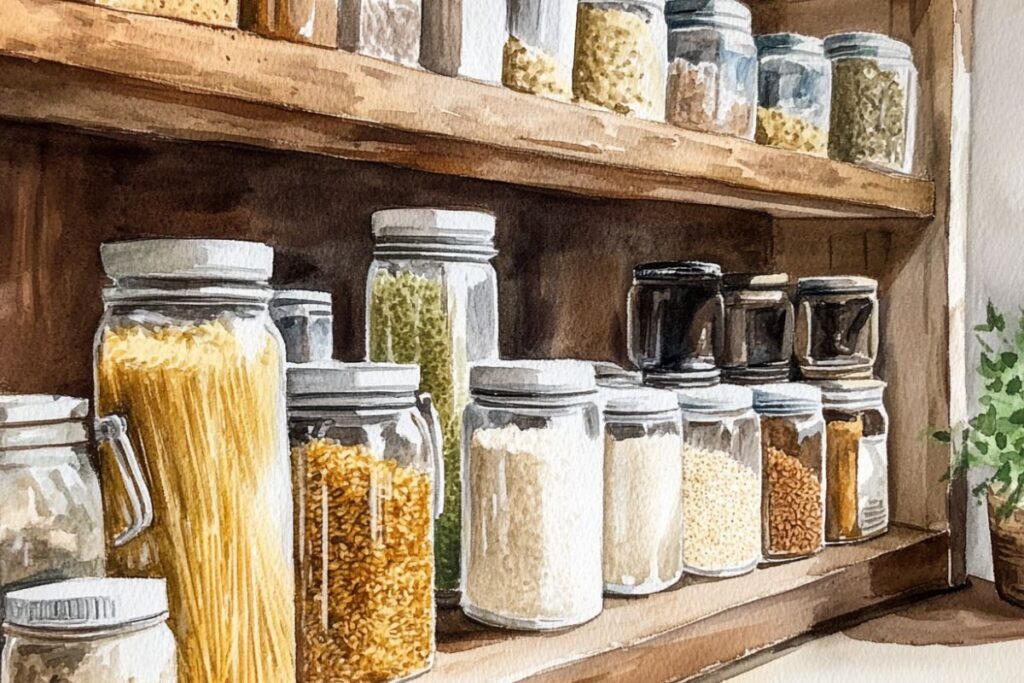
Hey there friends! Today we’re talking about stocking your pantry. Which I think gets a bad name sometimes because people assume you’re “prepping”.
And I’ll admit, this isn’t something that I’ve always been good about. In fact, there was a time that I only bought what I needed for the upcoming week in an effort to cut back on food waste. But over the years, as I’ve grown as a from-scratch cook, as well as having a better understanding of our food system, I no longer live by that standard.
Instead, my pantry is a place that has a steady supply of the items I need to be successful in my cooking endeavors.
Affiliate disclosure: This post may contain affiliate links. As an Amazon Associate this means I will earn a small commission if you choose to purchase through my links. This is at no extra cost to you! Read full disclosure here.
Why You Should Stock Your Pantry
I think sometimes “stocking the pantry” gets labeled as “prepping”. But having a healthy supply of foods that your family can and will eat shouldn’t be labeled as some extreme behavior.
Most of us can agree that having a savings account is a good idea. Emergencies happen and sometimes you need a little extra to make ends meet. We call this having financial security. So why not apply that same mindset to our food supply?
You’re not prepping, you’re being wise.

The ingredients listed here will give a supply of ingredients that you can make a number of different recipes from. I’ve found this to be so helpful when it comes to:
- Cooking at home.
- Sticking to a meal plan.
- Staying on budget.
- Making healthier choices.
No last-minute grocery store trips and no grabbing take-out because there’s nothing at home. You’ll have a food supply that serves you and your family well.
Keeping Your Pantry Organized
Now that you know what to stock, let’s talk about organization. A well-organized pantry can save you time and make cooking more enjoyable. Here are a few tips:
- Clear Containers: Store your goods in clear containers so you can easily see what you have. You can purchase new glass containers like the ones shown below, or you can search the thrift stores for them. You can also reuse certain large, food safe glass jars that you save. Things like pickle jars or pasta sauce can be cleaned and reused for storage.
- Long Term Storage Containers: If you’re planning to bulk buy ingredients for long term storage, having some large food safe buckets with an airtight lid is a must. These five-gallon buckets are perfect for keeping any pests out of your dry goods. Mylar bags are another option for storage.
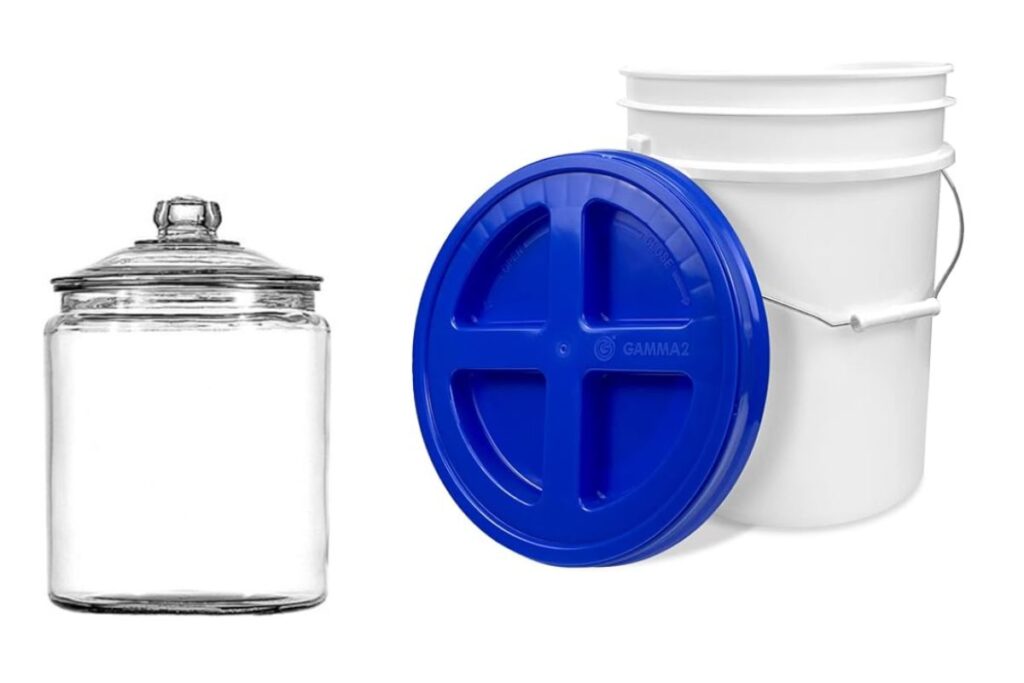
- Labeling: Label your containers so you can easily find what you need. This is especially helpful for spices and grains.
- Rotate Stock: When you buy new items, place them behind older ones to ensure you use the older items first. This helps minimize waste.
- Regular Check-ins: Periodically check your pantry for expired items and restock essentials. This keeps your pantry functional and ready for cooking!
These free kitchen inventory sheets that I offer are perfect for keeping your pantry organized:
How to Stock Your Pantry
Here’s an overview of what you need to stock your pantry well. Read below for a more detailed look at each one of the listed categories.

Grains and Legumes
1. Rice
Rice is such a versatile grain to keep on hand. White, brown, basmati, jasmine – there are so many options out there and it all stores well. Rice can be added to soups and casseroles, made into a stir fry, or my personal favorite – eaten with gravy.
2. Pasta
Dry pasta is a lifesaver for busy weeknights. Stock up on different shapes—spaghetti, penne, and orzo all have their uses. Plus, they pair wonderfully with a range of sauces and proteins, from a quick olive oil and garlic mix to a rich tomato sauce.
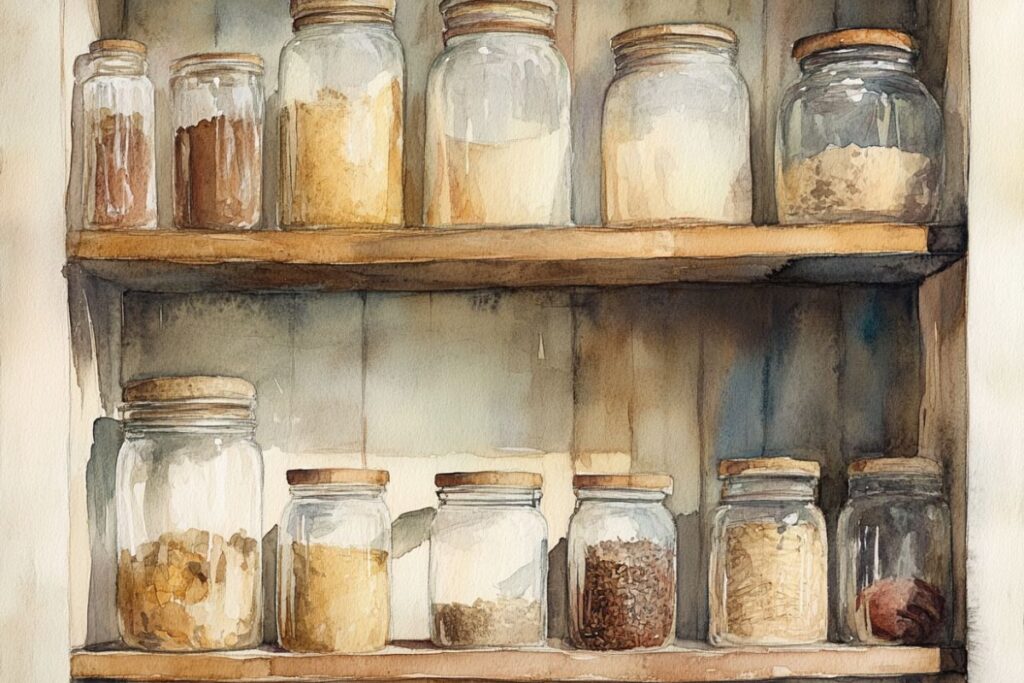
3. Quinoa
Quinoa is packed with protein and makes for a great alternative to rice. It’s super easy to cook and can be used in salads, bowls, or even as a side dish.
4. Lentils and Beans
Dried lentils and beans (like black beans, chickpeas, and kidney beans) are fantastic for adding protein and fiber to your meals. They’re great for soups, stews, or simply tossed into a salad for a nutritional boost.
You can also cook dry beans ahead of time and pressure can them for quick meals, or just buy already canned beans.
Baking Basics
5. Flour
You can’t bake without flour! Keep a healthy supply of all-purpose flour on hand for most baking needs. You can also stock up according to dietary needs, so whole-wheat or gluten-free options.
Take it a step further and start purchasing your very own wheat berries and using a grain mill to have freshly ground, nutritious, flour available.
6. Sugar/Sweeteners
Sugar and sweeteners should also be kept on hand for baking. The most popular option is granulated white sugar, but don’t forget about things like maple syrup and local honey. Molasses can also be stocked in order to make homemade brown sugar.
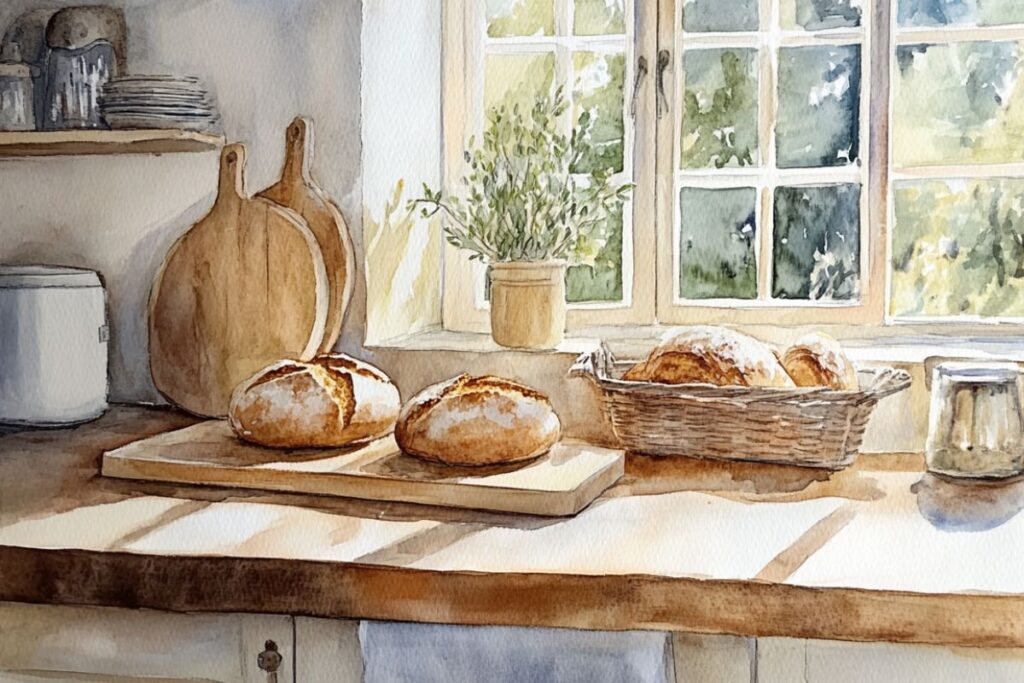
7. Baking Powder and Baking Soda
These leavening agents are essential for making your baked goods rise. Be sure to keep them sealed well in order to preserve the shelf-life.
8. Yeast
Yeast can also be purchased and stocked in bulk in order to make absolutely delicious homemade breads and rolls. Worried about it expiring? I keep my yeast in the freezer in a freezer safe container and have never had it go bad.
Oils, Vinegars, and Condiments
9. Oils
Oils are also an important part of cooking and baking. There is a wide range of oils to choose from. Avocado oil, olive oil, and coconut oil all serve a specific purpose in the kitchen. From sautéing, to making salad dressing, to baking, they all have a place an need.
11. Vinegar
Different types of vinegar (like balsamic, apple cider, and red wine vinegar) can elevate your dishes. They’re perfect for dressings, marinades, and even pickling.
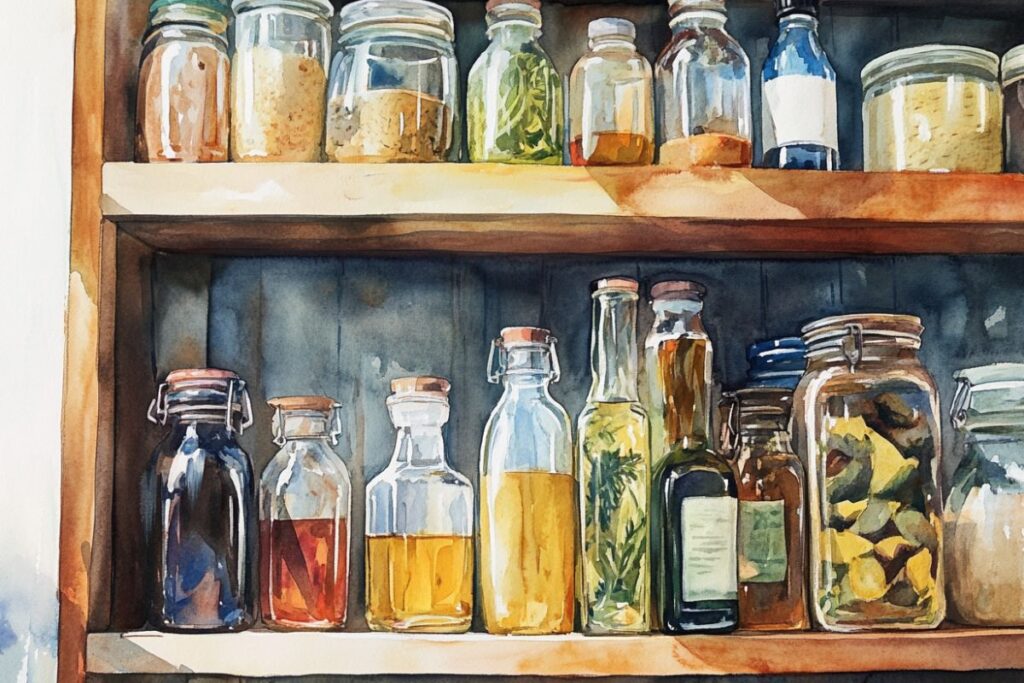
12. Soy Sauce or Alternative
A staple in Asian cuisine, soy sauce adds umami flavor to stir-fries, marinades, and even soups. If you’re avoiding gluten, there are great alternatives like tamari or coconut aminos.
13. Mustard
Dijon or yellow mustard can add a zesty kick to dressings, marinades, and sandwiches. It’s a small but mighty pantry hero!
14. Hot Sauce
For those who like a little heat, a good hot sauce can spice up almost any dish. From tacos to eggs, a dash can take your meal to the next level.
Canned and Jarred Goods
15. Tomatoes
Canned tomatoes are so, so versatile. Turn them into sauces, at to soups, stews, or casseroles, make salsa or ketchup – so many uses! Consider keeping a supply of all varieties (crushed, diced, sauce, etc.).
16. Broth
Whether chicken, beef, or vegetable, having broth on hand can enhance the flavor of your soups, stews, and risottos. You can even use it as a cooking liquid for grains. You can also purchase a powdered broth base which takes up much less storage space.

17. Coconut Milk
This creamy addition is perfect for curries, soups, and desserts. It adds a delightful richness and a hint of sweetness.
18. Nut Butters
Peanut butter and almond butter are fantastic for quick snacks, smoothies, or baking. They provide healthy fats and protein to keep you fueled.
Spices and Seasonings
19. Salt
It might seem basic, but salt is crucial. It elevates the flavor of your dish and often times, is the missing ingredient when you just feel like something is lacking. Not to mention, it also contains certain minerals that our bodies need in small amounts. Consider having kosher salt for cooking and fine sea salt for finishing dishes.
20. Pepper
Freshly cracked black pepper can elevate any meal. If you’re feeling adventurous, try adding different types of peppercorns for a unique twist!
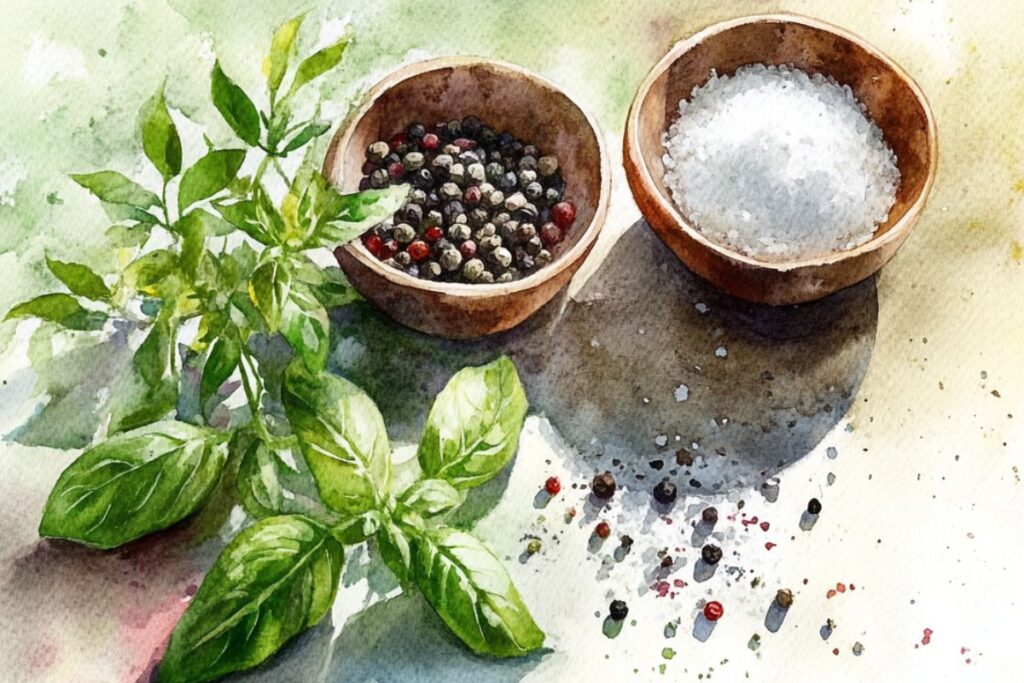
21. Essential Spices
Keep a selection of spices that you love. Think cumin, paprika, chili powder, cinnamon, and oregano. They’ll allow you to add depth and complexity to your dishes.
22. Herbs
Dried herbs like basil, thyme, and rosemary are fantastic for adding flavor without the need for fresh ingredients. If you love fresh herbs, consider growing your own in a little window box!
Snacks and Extras
23. Nuts and Seeds
Nuts and seeds are perfect for snacking, topping salads, or adding to granola. They’re also great sources of healthy fats and protein that store well long term.

24. Dried Fruits
Raisins, apricots, or cranberries can add sweetness to salads, trail mixes, or baked goods. Plus, they last a long time, making them a great pantry staple.
25. Popcorn
Whole popcorn kernels store excellent in the pantry and make a perfect snack! You can pop them on the stovetop or buy a popcorn popper. You can air pop, or use a fat source (oil, butter, bacon grease) to pop it in for a little extra flavor. Sprinkle with salt and you’re good to go!
Final Thoughts
Stocking your pantry doesn’t have to be overwhelming. Start with these essentials, and over time, you’ll discover your favorite ingredients to personalize your pantry. Remember, the goal is to have a variety of items on hand that inspire you to cook delicious meals from scratch.
Happy cooking, and here’s to many delightful meals made from your well-stocked pantry! If you have any favorite pantry staples or tips, feel free to share in the comments. Let’s keep this conversation going!